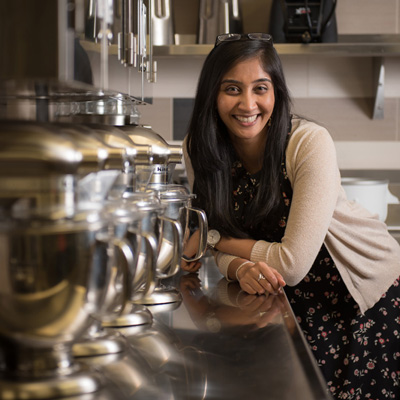 Dr. Bhavika Patel in the Teaching KitchenMedical students and family medicine residents at the College of Community Health Sciences who are taking The University of Alabama’s new Culinary Medicine elective had their first class January 26. The course is a partnership of UA’s College of Community Health Sciences - which serves as the Tuscaloosa Regional Campus
Dr. Bhavika Patel in the Teaching KitchenMedical students and family medicine residents at the College of Community Health Sciences who are taking The University of Alabama’s new Culinary Medicine elective had their first class January 26. The course is a partnership of UA’s College of Community Health Sciences - which serves as the Tuscaloosa Regional Campus
Through lectures, hands-on cooking classes, and follow-up discussions, the class will teach CCHS medical students and residents, as well as CHES nutrition students, how to better educate patients about their diets. Students and residents will learn the fundamentals of cooking and how to share with patients the basics of preparing healthy and delicious meals so that they can be more helpful when addressing chronic disease management and obesity. Classes are held in the CHES teaching kitchen.
Bhavika Patel, M.D., chief resident at CCHS’s Family Medicine Residency Program, helped jumpstart the Culinary Medicine elective. After witnessing extreme malnutrition in India, where she received part of her medical education, then studying the effects of food deserts (geographic areas where affordable and nutritious food is difficult to obtain) and the high rates of obesity in the rural United States, she says she wants to combat these effects by being there for her patients beyond the exam room.
Patel says medical education has traditionally taught nutrition on a theoretical and cellular level, but that’s not helpful when a lifestyle change is needed. “That’s where culinary medicine comes in,” she says. “It focuses on educating everything that is missing and could be valuable in teaching patients how to change their lifestyle and not just on what needs to be done. This is a much more powerful method of change rather than the more passive forms of education that physicians have been using for years.”
|
“(Culinary medicine) focuses on educating everything that is missing and could be valuable in teaching patients how to change their lifestyle and not just on what needs to be done. This is a much more powerful method of change rather than the more passive forms of education that physicians have been using for years.” |
Twenty-four students are taking the course – 10 medical students, eight nutrition students and six residents. The course is taught by Jennifer Clem, M.D., assistant professor in family medicine for CCHS, and Linda Knol, Ph.D., R.D., associate professor of human nutrition for CHES.
The course pulls from modules of the curriculum of the Goldring Center for Culinary Medicine at the Tulane University School of Medicine in New Orleans and includes principles of diabetes, weight and portion control, hypertension, sodium, carbohydrates and the Mediterranean diet.
“I have patients who are overweight, who have diabetes, and that’s why I’m here,” Clem told the students.
During the first class, students divided into three teams of eight and participated in a cooking exercise. Teams prepared dinners of whole-wheat pasta, some topped with meat sauce and some with lentils and vegetables, as well as salads with lettuce, kale, carrots, and other vegetables. After the cooking exercise, they discussed the nutritional content of the dishes, learning, for example, that using whole-wheat pasta increases the amount of fiber in one’s diet.
Richard Streiffer, M.D., dean of CCHS and a family medicine physician, touted the benefits of the interprofessional aspect of the course. “Doctors don’t learn enough about nutrition in medical school, and a great majority of chronic disease is nutrition related,” he said. “Other disciplines have greater practice with this. We can learn from each other.”
By Leslie Zganjar